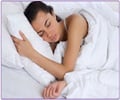Sleep patterns are closely linked to body characteristics across 16 systems, highlighting the effects of age, obesity, and lifestyle on sleep, along with gender differences in sleep-related health conditions.
- Sleep patterns change with age, with deep sleep declining and and light sleep increasing
- Lifestyle factors and body composition are stronger predictors of sleep quality than age or BMI
- Gender differences emerge in sleep-related health issues, with links to conditions like hypertension, osteopenia, and allergies
Phenome-wide associations of sleep characteristics in the Human Phenotype Project
Go to source). A team of researchers led by Eran Segal, Ph.D., from the Department of Computer Science and Applied Mathematics at the Weizmann Institute of Science in Rehovot, Israel, examined sleep data from the Human Phenotype Project. This longitudinal study gathers comprehensive clinical and molecular data from healthy individuals aged 40-70 years in the general Israeli population.
The study examined data from 448 sleep characteristics gathered over 16,812 nights of home sleep apnea test monitoring, involving 6,366 adults (averaging 2.42 nights per individual). Wearable sensors were used to track breathing, snoring, sleep position, sleep phases, and heart rates. Of the participants, 47.8% were men, with an average age of 52.4 years and an average body mass index of 26.1. Furthermore, 574 participants were monitored twice, two years apart, to evaluate changes in sleep parameters over time.
Most human infants need about 16 hours of sleep a day–about the same as a full-grown tiger! The sleepiest animal in the world is the koala, which spends about 18-22 hours a day snoozing. #medindia #sleep #infants’
Age-Related Changes in Sleep Patterns
The analysis revealed that sleep patterns change with age. Deep sleep declined by 0.13%-0.14% annually, while light sleep increased by 0.18%-0.23%. The peripheral apnea-hypopnea index (pAHI) also rose significantly with age, aligning with findings from previous studies. By age 40, 10% of men develop obstructive sleep apnea, while women surpass this threshold around age 55, likely due to the onset of menopause.Certain sleep parameters, such as snoring and oxygen saturation, remained fairly consistent. However, sleep patterns and the pAHI demonstrated noticeable changes over time. On average, deep sleep makes up just under 18% of total sleep time, with similar percentages observed in both men and women, and the average sleep duration is around 6 hours per night.
Correlations Between Sleep and Body Characteristics
The study analyzed 25,164 correlations, identifying over 12,400 significant ones. The strongest associations were found between the peripheral apnea-hypopnea index (pAHI) and body characteristics, especially visceral adipose tissue, blood triglyceride levels, and bone density in the rib area. Regarding lifestyle factors, pAHI was linked to television use and smoking habits. Additionally, heart rate variability during sleep was associated with sex, frailty, and bone density.In addition to individual parameters, this study explored how the sleep system interacts with 16 other physiological systems, including kidney function, immune response, microbiome composition, and mental health. The research also considered lifestyle factors such as medication use, diet, and overall lifestyle.
The findings showed that sleep measures, when considered together, are stronger predictors of insulin resistance and blood lipid levels than measures from any other body system. However, sleep itself does not directly predict visceral adipose tissue levels, indicating that visceral fat is unlikely to mediate the relationship between sleep and insulin resistance.
In contrast, among the body systems analyzed, lifestyle emerged as the strongest predictor of sleep quality, surpassing the influence of age, body mass index, and visceral fat. Other significant factors affecting sleep parameters included the cardiovascular system, insulin resistance, hematopoietic function, lipid metabolism, and psychological health.
Gender Differences in Sleep-Related Health Issues
Sleep parameters are linked to various diseases, but the correlations differ between men and women. In women, sleep is associated with hypertension, osteopenia, and prediabetes, while in men, it is more strongly connected to allergies and back pain. Heart rate variability during sleep is related to hypertension, atopic dermatitis, and hearing loss in men, whereas in women, it is more closely tied to asthma, osteoporosis, and anxiety.Overall, sleep structure, including duration and the percentage of deep sleep, seems to be more closely linked to endocrine conditions, while the peripheral apnea-hypopnea index (pAHI) serves as a stronger predictor of cardiovascular and metabolic diseases.
However, some commonly proposed associations were found to be weak or absent. For instance, liver health and kidney function showed little correlation with sleep duration. Additionally, previous hypotheses regarding the impact of diet and microbiomes on individual sleep characteristics appear to have limited support. However, microbiome metabolism was strongly associated with obstructive sleep apnea in both sexes, while diet was linked to obstructive sleep apnea only in women.
Visceral Fat and Sleep-Related Breathing Disorders
A researcher stated that,“This study confirms several well-established associations between sleep and other physiological parameters. Its novelty lies in the extensive data collected in a home setting, which enabled researchers to identify and directly compare the most relevant associations, offering a more comprehensive and holistic perspective than previous studies. Among these associations, the strongest connection was found between sleep-related breathing disorders and body composition, particularly visceral adipose tissue. In contrast, the links between sleep and renal function, nutrition, and microbiota were weaker than anticipated,” he added.Giorgio Gilestro, Ph.D., a reader in systems neurobiology at Imperial College London, specializing in sleep biology and neurobiology, remarked that while "the study is valuable due to the large number of subjects in the cohort examined, it is not particularly innovative from a scientific standpoint because it mainly confirms existing knowledge rather than introducing new findings." The main confirmation, he noted, is that obesity, particularly visceral fat, is the strongest factor associated with sleep apnea. "It has been known for decades that the best way to combat sleep apnea is weight loss," said Gilestro.
"Secondly, it is yet another large-scale study that disproves the myth that we all need to sleep 8 hours a night. Biology doesn't work that way. It would be like assuming we all need to wear the same shoe size," Gilestro explained.
In conclusion, this study points out the complex relationship between sleep and various health factors, revealing distinct gender differences and the significant role of obesity and lifestyle in sleep apnea. It also challenges the myth of a universal 8-hour sleep requirement, emphasizing the need for personalized approaches to sleep health.
Reference:
- Phenome-wide associations of sleep characteristics in the Human Phenotype Project - (https://www.nature.com/articles/s41591-024-03481-x)
Source-Medindia
















